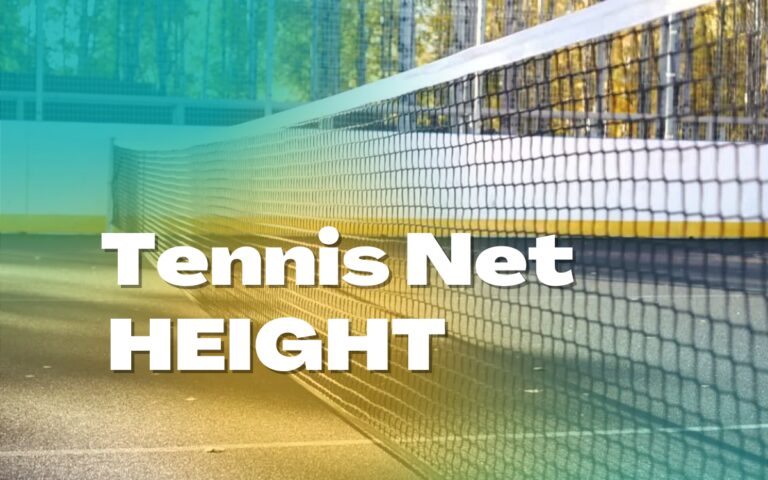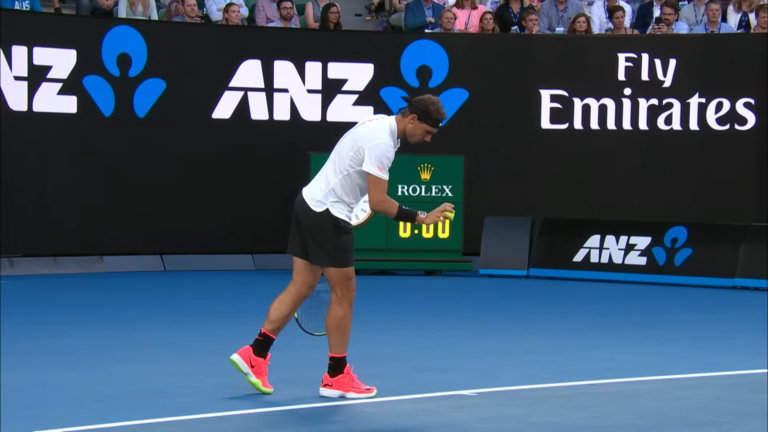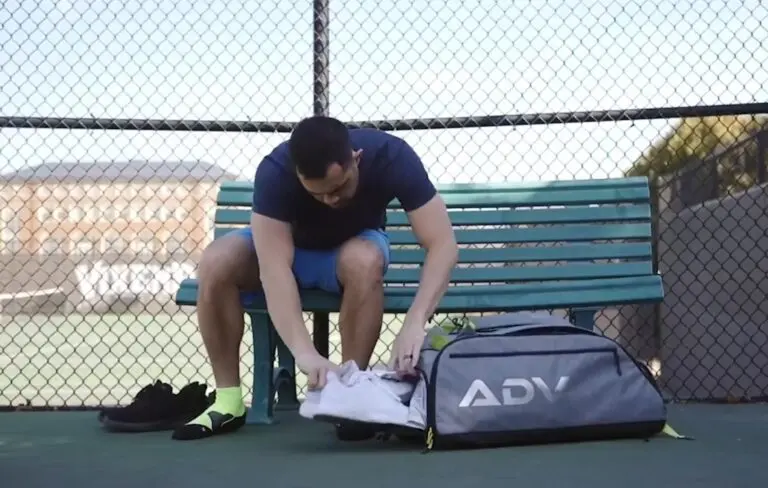When you step onto the tennis court, the thrill, challenge, and passion of the game come alive, largely due to the equipment at your disposal. The excitement heightens each time you successfully lob the ball over the net and into your opponent’s court.
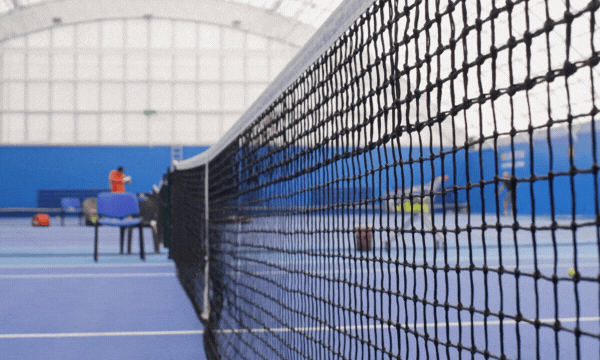
However, if you’re unable to clear the net with your shots, all your power and skill amount to nothing. This underscores the importance of practicing with the proper equipment – a quality tennis racket, a good set of balls, and a properly installed tennis net.
Perhaps you’re considering setting up a tennis net in your backyard or local playground for practice, but you’re unsure about the correct tennis net height. If that’s the case, you’re in the right place. In this article, we’ll delve into everything you need to know about the precise height of a tennis net.
What Is The Height of a Tennis Net?

Per the International Tennis Federation (ITF), the standard height of a tennis net is 42 inches (106.5cm) at the posts and approximately 36 inches (91.5cm) at the center. It’s vital to get these measurements right when installing a tennis net, as any imbalance can significantly impact the game.
Adhering to the standard net height is key to avoiding confusion during play. If a player has been practicing with a net of a different height, even an extra inch can lead to more missed shots than usual. Believe me, I’ve been there!
The height of a tennis net is measured at three points: the center and each post. It’s important to note that these measurements are taken to the top of the net tape.
| Measurement | Height at Center | Height at Posts |
| Inches | 36” | 42” |
| Feet | 3′ | 3’6” |
| Meters | 0.91m | 1.07m |
| Centimeters | 91.4cm | 1067cm |
Setting Up
To set up a tennis net at the correct height, you’ll need four key items: two net posts, a metal cable, a white strap, and a white band. When installing the net, ensure that the posts are set up at a height of 42 inches.
The center of the tennis net should be approximately 36 inches above the ground. To achieve this, you’ll need to use the white strap to secure the center of the net to the ground.
I recommend using a white strap no more than 2 inches wide. It’s vital to secure the center of the net to the ground using the white band. The net should be positioned so that it’s evenly divided between the two posts. Ensure that the net is tightly woven to prevent the tennis ball from passing through during play.
Lowering At The Center

The height of the net posts is greater than the height of the tennis net at the center. This is done to maintain balance across the net. According to the ITF, the center of the tennis net should stand at about 36 inches high, while the posts should reach a height of 42 inches.
This design is often referred to as a strategic trade-off. Just as in many games where the simplest move can be the most challenging, tennis becomes more exciting when you aim for the center of the net. The lower net height at the center encourages strategic play and adds an extra layer of thrill to the game.
Doubles Differences
If you’re setting up a tennis net for doubles play, you’ll need to consider the wider dimensions of the court. For singles play, the court’s width is 324 inches, but for doubles, it expands to 432 inches.
In singles play, the net is narrower and stands 3.5 feet high at the sides. However, for doubles matches, the tennis net should maintain the standard height of 42 inches at the posts and 36 inches at the center. If you’re using a net for doubles play, it should be supported by singles sticks at the sides.
The net posts should not exceed 6 inches in diameter, and the singles sticks, which help define the width of the singles court within the doubles court, should be 3 feet high.
Junior Differences
The height of a junior tennis net is typically set at 2 feet and 9 inches above the ground. This height strikes a balance, providing a fair playing surface for younger players without being so high that it becomes challenging to hit over.
The USTA categorizes junior players’ programs into four stages: red, orange, green, and yellow. Depending on the stage, the net height can vary from 2 feet 9 inches to 3 feet 6 inches. This progressive increase in net height allows young players to gradually adapt to the standard net height as they develop their skills.
| Stage | Net Height |
| Red | 2’9” |
| Orange | 3’6” |
| Green | 3’6” |
| Yellow | 3’6” |
Cross-court Vs. Down-the-line
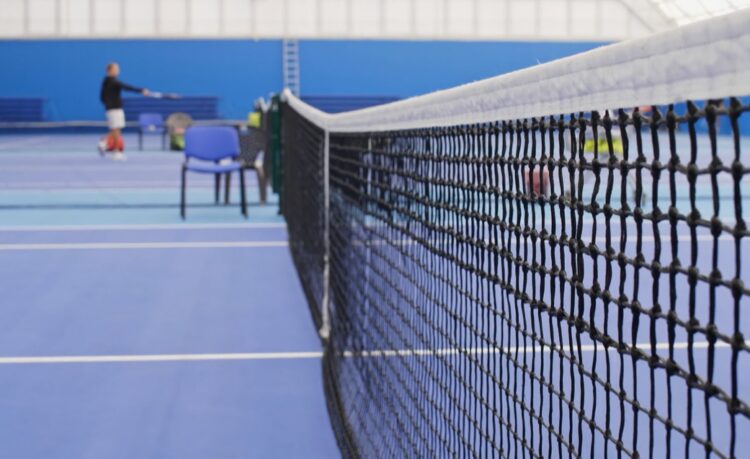
In tennis, it’s often thought that the most challenging shot is one that’s hit with full force towards the opponent, as it can be difficult to return. However, when it comes to down-the-line shots, these can be particularly tricky due to the net’s height being highest at the sides, leaving a narrower window for the shot.
On the other hand, cross-court shots are generally easier and safer to execute because the net is lower in the middle.
I’ve come to believe that the tennis net can sometimes dictate the outcome of a match. In some games, it might seem like the net is working against you, while in others, it could be your greatest ally. Those shots that just graze the net can often be game-changers.
Many professional players, as well as beginners or recreational players, prefer cross-court shots due to these factors.
Adjusting Height
Adjusting the height of a tennis net is a straightforward process. All you need is a measuring stick, which you can easily find in sports stores or online.
These sticks, often made of wood, are handy tools for ensuring your net is at the correct height. Simply use the stick to measure the height of the net from the ground. According to the International Tennis Federation, the net should stand at about 3 feet high in the center.
Remember, accurate measurements are key to maintaining the integrity of the game, so it’s worth investing in a good measuring stick.
FAQ

What is the accurate height of a tennis net?
According to the International Tennis Federation, the standard height of a tennis net is 42 inches at the posts and 36 inches at the center. This means the net should stand about 3 feet high from the ground at its center.
The precise height of the tennis net is crucial for players, as even a slight deviation can significantly impact the game.
How can you adjust the tennis net height?
You can adjust the height of a tennis net using a measuring stick. These sticks, often made of wood, are easy to handle and allow you to quickly measure and adjust the net’s height.
To ensure a fair and exciting game, adjust the net to stand 3 feet high from the ground at its center.
Why is the tennis net lowered at the center?
The tennis net is lower at the center to maintain balance across the net. The posts that hold up the net are taller than the net’s width, so to compensate for this, a white band is used to lower the center of the net towards the ground.
Conclusion
As tennis enthusiasts, we understand the pivotal role that the height of the tennis net plays in our game. Whether we’re beginners, recreational players, or professionals, the right net height can make our matches more thrilling and challenging. Conversely, even a slight deviation from the standard height can drastically affect our performance and potentially cost us the match.
We’ve explored the importance of the tennis net, the standard heights set by the International Tennis Federation, the differences in net height for singles and doubles play, and even the varying heights for junior players. We’ve also delved into the strategic implications of the net’s height in cross-court and down-the-line shots and provided a guide on how to set up and adjust your tennis net.
Armed with this knowledge, you’re now well-equipped to set up a tennis net for your practice matches or even a friendly competition in your backyard. Remember, the game of tennis is as much about precision and strategy as it is about power and skill.
So, the next time you step onto the court, take a moment to appreciate the humble tennis net – it might just be the unsung hero of your next thrilling match
Related:
- Top 19 Best Tennis Bags 2024 [Unbiased Reviews]
- 20 Best Tennis Shoes 2024 - Stylish and Athletic
- 18 Best Tennis Racquets 2024 - Exclusive Reviews &…
- 15 Best Tennis Balls 2024 - USTA and ITF Approved
- 15 Best Tennis Racquet for Beginners & Intermediate…
- 10 Best Tennis Ball Machine 2024 - Perfect for Solo Players

